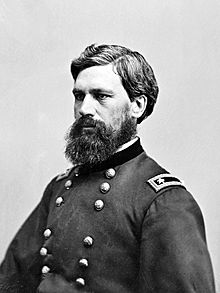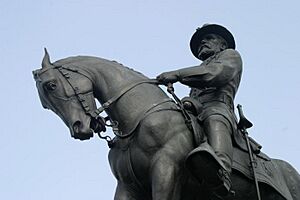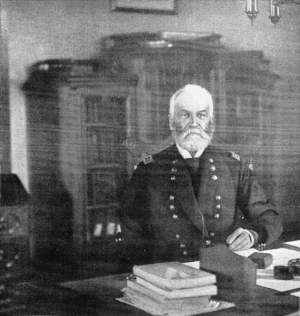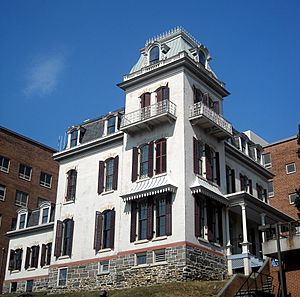Oliver Otis Howard facts for kids
Quick facts for kids
Oliver Otis Howard
|
|
|---|---|

Howard during the Civil War
|
|
| Nickname(s) |
|
| Born | November 8, 1830 Leeds, Maine, U.S. |
| Died | October 26, 1909 (aged 78) Burlington, Vermont, U.S. |
| Place of burial |
Lakeview Cemetery, Burlington, Vermont
|
| Allegiance | United States (Union) |
| Service/ |
|
| Years of service | 1854–1894 |
| Rank | |
| Commands held |
|
| Battles/wars | |
| Awards | |
| Alma mater |
|
| Other work | President, Howard University Managing Director, Lincoln Memorial University |
| Signature | |
Oliver Otis Howard (November 8, 1830 – October 26, 1909) was an important United States Army officer and a Union general during the Civil War. He is known for losing his right arm in battle, earning the Medal of Honor. After the war, he led the Freedmen's Bureau, helping formerly enslaved people. He also helped start Howard University. Howard later commanded troops in the West, including a famous campaign against the Nez Perce tribe.
He was often called the "Christian General" because his decisions were guided by his strong religious beliefs.
Contents
Early Life and Education
Oliver Howard was born in Leeds, Maine. His father, a farmer, passed away when Oliver was nine. He went to several schools, including Monmouth Academy and North Yarmouth Academy. He graduated from Bowdoin College in 1850 when he was 19.
After college, he attended the United States Military Academy (West Point). He graduated in 1854, ranking fourth in his class. He became a second lieutenant in the army. He worked at arsenals in New York and Maine. In 1855, he married Elizabeth Anne Waite, and they had seven children.
In 1857, he was sent to Florida for the Seminole Wars. During this time, he became a strong evangelical Christian. He even thought about leaving the army to become a minister. However, when the Civil War began, he decided to stay and serve his country. He was promoted to first lieutenant in July 1857 and later taught mathematics at West Point.
Howard in the Civil War
When the Civil War started, Howard became a colonel of the 3rd Maine Infantry regiment. He led a brigade at the First Battle of Bull Run. In September 1861, he was promoted to brigadier general. He then joined Maj. Gen. George B. McClellan's Army of the Potomac for the Peninsula Campaign.
On June 1, 1862, during the Battle of Fair Oaks, Howard was badly wounded in his right arm. It had to be amputated. For his bravery, he received the Medal of Honor in 1893. Another general, Philip Kearny, who had also lost an arm, joked with Howard about their shared experience. Howard recovered quickly and returned to the army for the Battle of Antietam. There, he commanded a division. In November 1862, he became a major general. The next April, he took command of the XI Corps. Many soldiers in this corps were German immigrants who didn't speak English well. They were not happy with Howard as their new leader.
Challenges at Chancellorsville
At the Battle of Chancellorsville in May 1863, Howard faced a major defeat. His corps was on the far right side of the Union army. Generals Robert E. Lee and Thomas J. "Stonewall" Jackson planned a surprise attack. Jackson's corps secretly marched around the Union flank and attacked Howard's troops. Howard had been warned that his flank was exposed, but he didn't take enough precautions. Jackson's attack routed the XI Corps, causing big problems for the Union army.

The Battle of Gettysburg
The XI Corps arrived at the Battle of Gettysburg on July 1, 1863. Still recovering from their defeat at Chancellorsville, they faced another tough day. Their defensive line was not well placed, and Confederate forces attacked. The XI Corps was forced to retreat through the town, and many soldiers were captured.
On Cemetery Hill, south of Gettysburg, Howard had a disagreement with Maj. Gen. Winfield S. Hancock about who was in charge. Hancock had written orders to take command, but Howard insisted he was the highest-ranking general there. He eventually gave in. Historians debate Howard's actions that day. Some say he wisely chose Cemetery Hill as a key defense point. Others criticize his timing in ordering a retreat. However, Howard did place one of his divisions on Cemetery Hill as a reserve, which proved important for the battle's success. For the rest of the three-day battle, the XI Corps defended Cemetery Hill. Howard's younger brother, Charles Henry Howard, served as his aide during the battle.
Success in the Western Theater
After Gettysburg, Howard and the XI Corps moved to the Western Theater of the war. They joined the Army of the Cumberland in Tennessee. In the Battles for Chattanooga, Howard's corps helped capture Missionary Ridge, forcing the Confederates to retreat.
In July 1864, after the death of Maj. Gen. James B. McPherson, William Tecumseh Sherman appointed Howard to command the Army of the Tennessee. Howard then led the right wing of Sherman's famous March to the Sea through Georgia and later the Carolinas. Sherman praised Howard as a corps commander with "the utmost skill, nicety and precision."
After the War
Leading the Freedmen's Bureau
From May 1865 to July 1874, General Howard was the commissioner of the Freedmen's Bureau. This was a special army bureau created to help formerly enslaved people (freedmen) adjust to life after slavery. Howard played a huge role in the Reconstruction era.
He created many programs, including:
- Providing food and supplies.
- Setting up schools.
- Establishing courts to protect freedmen's rights.
- Offering medical care.
Howard often disagreed with President Andrew Johnson, who wanted to give political power back to Southern white people. However, Howard had the support of the Radical Republicans in Congress. When the Radical Republicans gained power, they gave Black men the right to vote in the South. The Bureau helped Black people organize politically. This made the Bureau a target for those who opposed Reconstruction.
Military Commands and Native American Affairs
In 1872, Howard was sent to Arizona Territory to negotiate a peace treaty with the Apache leader Cochise. They signed a treaty on October 12.
In 1874, he took command of the Department of the Columbia in the West. He fought in the Indian Wars, especially against the Nez Perce tribe in 1877. This led to the surrender of Chief Joseph. Chief Joseph later criticized Howard, saying the war could have been avoided if Howard had given his people more time and treated their leaders with respect.
Howard also served as the superintendent of the U.S. Military Academy from 1881 to 1882. He commanded other military departments until he retired from the U.S. Army in 1894 as a major general. The French government honored him with the Legion of Honor.

Founding Howard University
General Howard is also famous for helping to found Howard University in Washington, D.C. The university was started in 1867. It was open to all people, regardless of race or gender. Howard was among a group of people who met in 1866 to plan a school for Black ministers. However, they soon decided to create a larger educational institute. The school was first called the Howard Normal and Theological Institute. On January 8, 1867, it was renamed Howard University. Howard served as its president from 1869 to 1874. He also helped found Lincoln Memorial University in Tennessee in 1895, which aimed to educate "mountain whites."
Death and Burial
Oliver Howard passed away in Burlington, Vermont, on October 26, 1909. He is buried at Lakeview Cemetery in Burlington. At the time of his death, Howard was the last surviving Union Army general who held a permanent general rank in the regular U.S. Army.
Howard's Legacy
A statue of Howard can be found on East Cemetery Hill at the Gettysburg Battlefield. A dormitory at Bowdoin College is named after him.
The Oliver O. Howard Relief Corps helped former Union soldiers who were struggling. They also supported public causes, like contributing to the design of the State Flag of Utah in 1920. An Army Reserve Center in Auburn, Maine, is named after him.
Several schools are named in his honor, including Howard High School of Technology in Delaware and the Howard School of Academics and Technology in Tennessee. Howard, Kansas, is also named after him.
The General Oliver Otis Howard House at the Fort Vancouver National Historic Site was built under his order in 1878. Today, it serves as the headquarters for the Fort Vancouver National Trust.
In Portland, Oregon, a wreath was laid at his former home in 2012 to honor his bravery during the Battle of Fair Oaks. June 2012 was dedicated to Howard, with events highlighting his work in Portland and his achievements with the Freedmen's Bureau, Howard University, and in the Indian Wars.
Books by Howard
Oliver Howard wrote several books after the Civil War, including:
- Donald's School Days (1878)
- Nez Perce Joseph (1881)
- General Taylor (1892)
- Isabella of Castile (1894)
- Fighting For Humanity, or Camp and Quarterdeck (1898)
- Henry in the War: Or the Model Volunteer (1899)
- Autobiography (1907)
- My Life and Experiences among Our Hostile Indians (1907)
He also wrote about the Civil War's Atlanta campaign for Century Magazine in July 1887.
Howard in Movies and TV
Oliver Otis Howard has been shown in several films and TV shows:
- In the 1950 film Broken Arrow, he was played by Basil Ruysdael.
- In the 1956 film The Last Wagon, he was played by Carl Benton Reid.
- James Whitmore played General Howard in the 1975 TV movie, I Will Fight No More Forever, which was about the Nez Perce War.
- In episode 6 of The West, his voice was provided by Eli Wallach.
- He is also a main character in William T. Vollmann's novel The Dying Grass (2015).
Military Ranks Held
| Insignia | Rank | Date | Component |
|---|---|---|---|
| No insignia | Cadet, USMA | 1 September 1850 | Regular Army |
| Second Lieutenant | 1 July 1854 (brevet) 15 February 1855 (permanent) |
Regular Army | |
| First Lieutenant | 1 July 1857 | Regular Army | |
| Colonel | 4 June 1861 | Volunteers | |
| Brigadier General | 3 September (accepted 5 September) 1861 | Volunteers | |
| Major General | 29 November 1862 | Volunteers | |
| Brigadier General | 21 December 1864 | Regular Army | |
| Major General | 19 March (accepted 2 April) 1886 | Regular Army |
Awards and Honors
- Medal of Honor
- Thanks of Congress
- Civil War Campaign Medal
- Indian Campaign Medal
- Commander, Legion of Honor (France)
See Also
 In Spanish: Oliver Otis Howard para niños
In Spanish: Oliver Otis Howard para niños
- List of American Civil War Medal of Honor recipients: G–L
- List of American Civil War generals (Union)
- Sherman's March (2007, documentary)
- Charles Henry Howard (brother)






